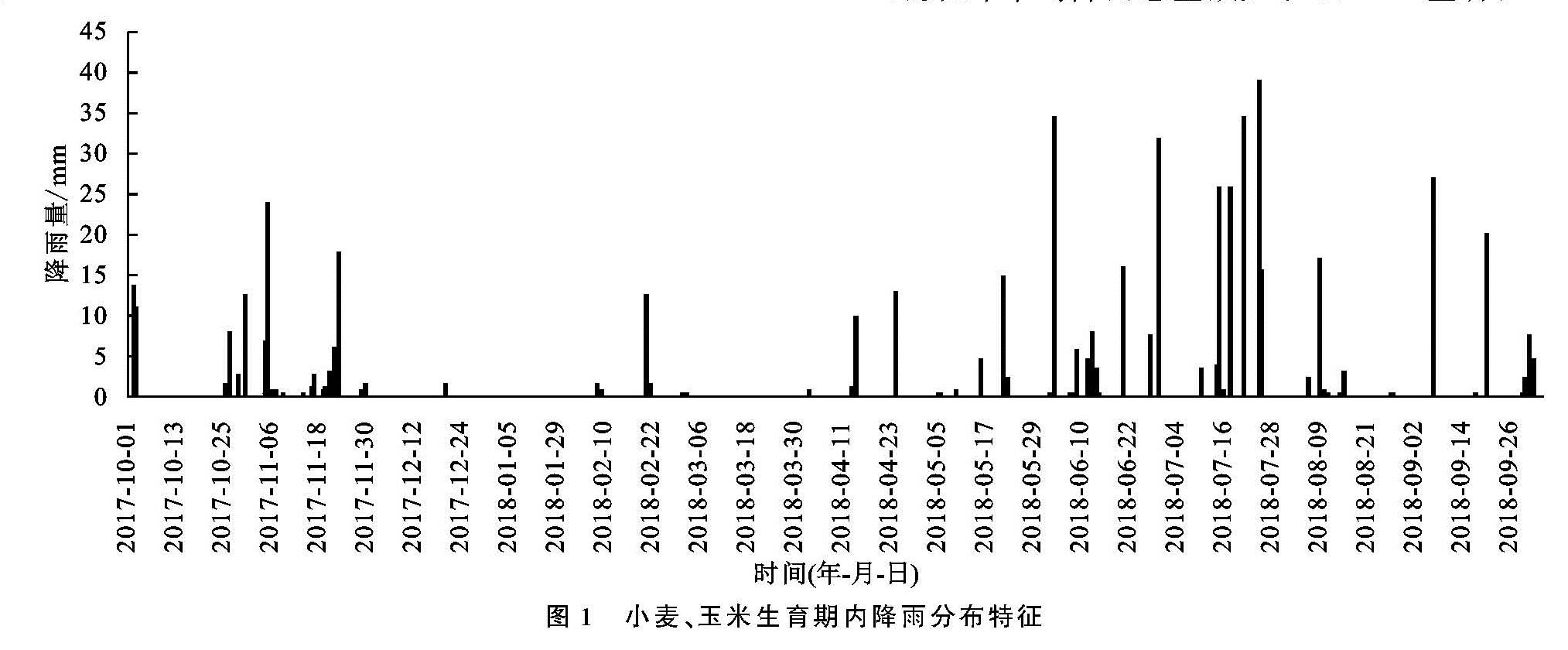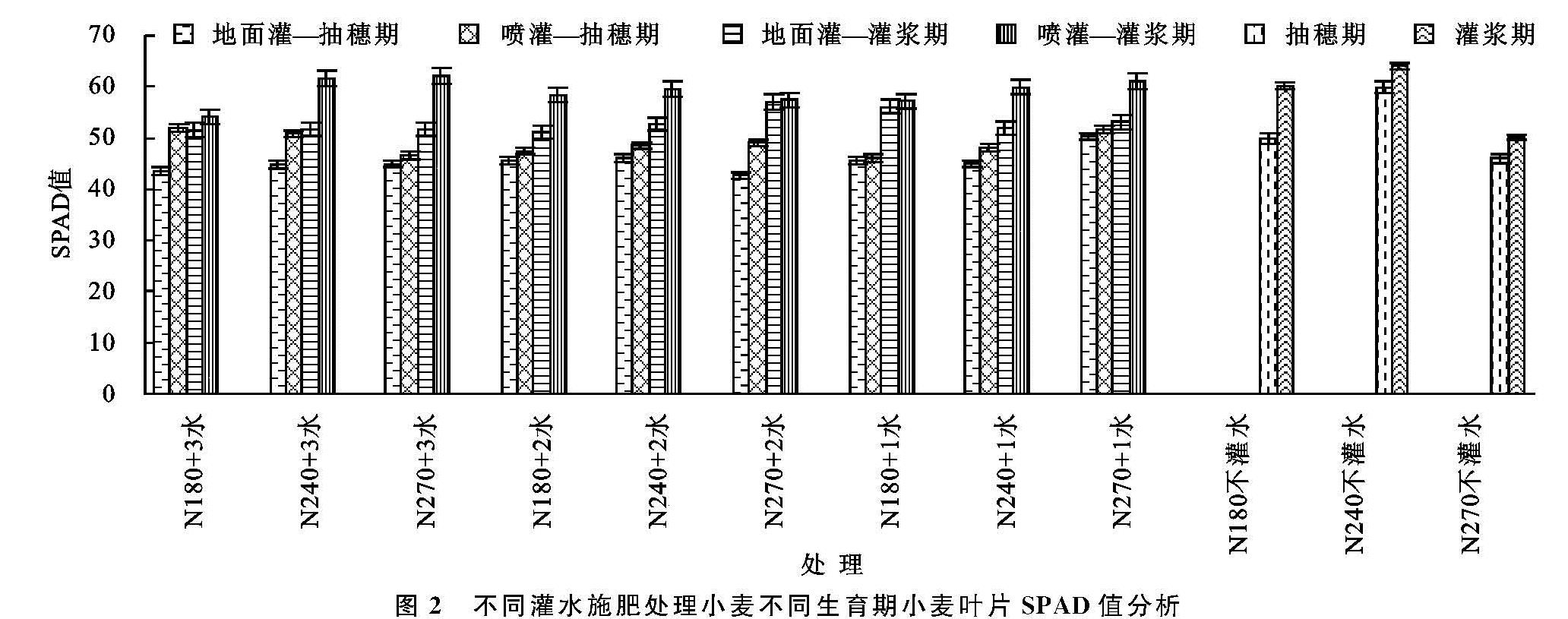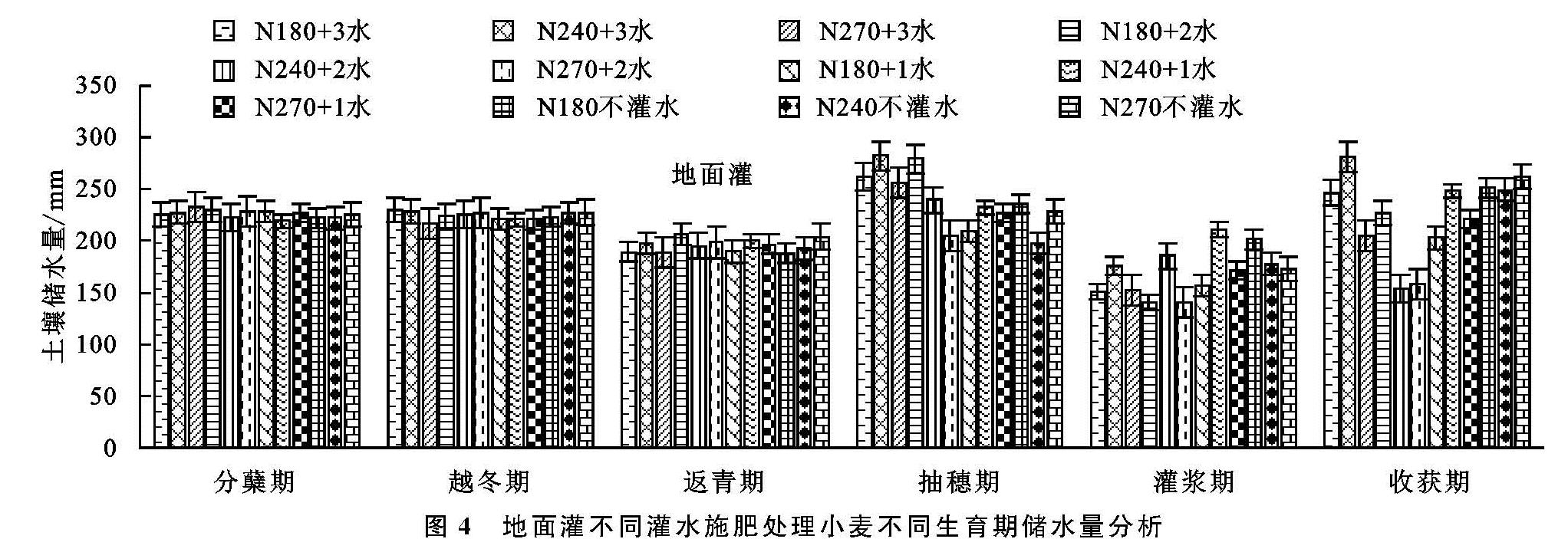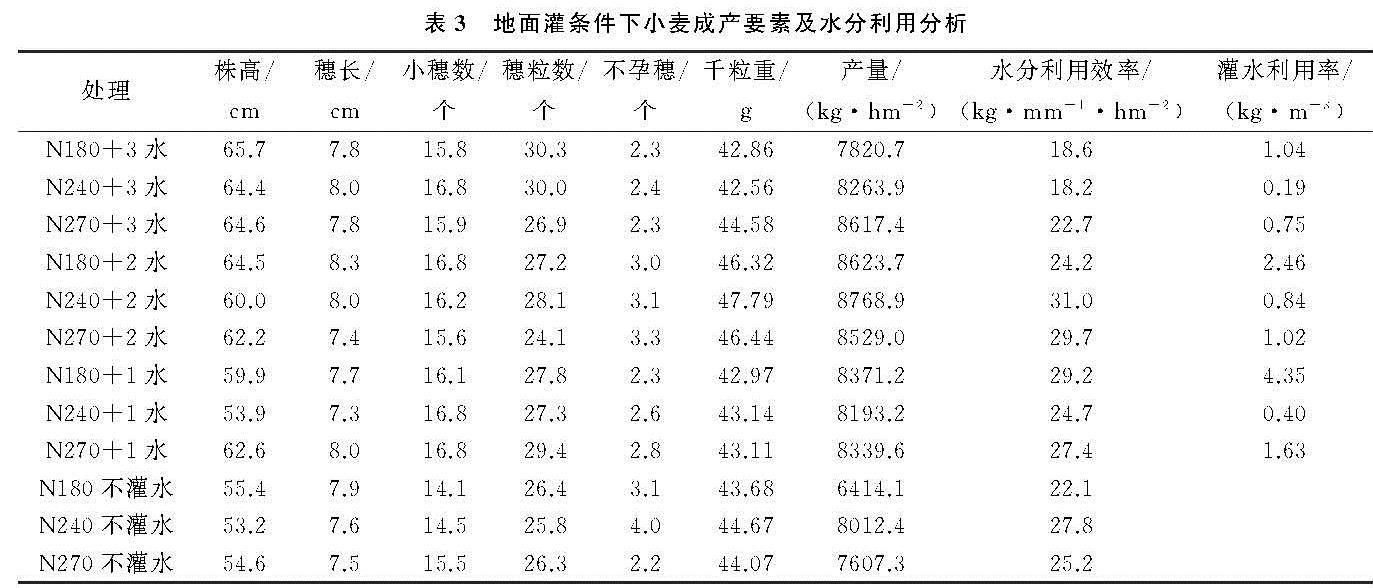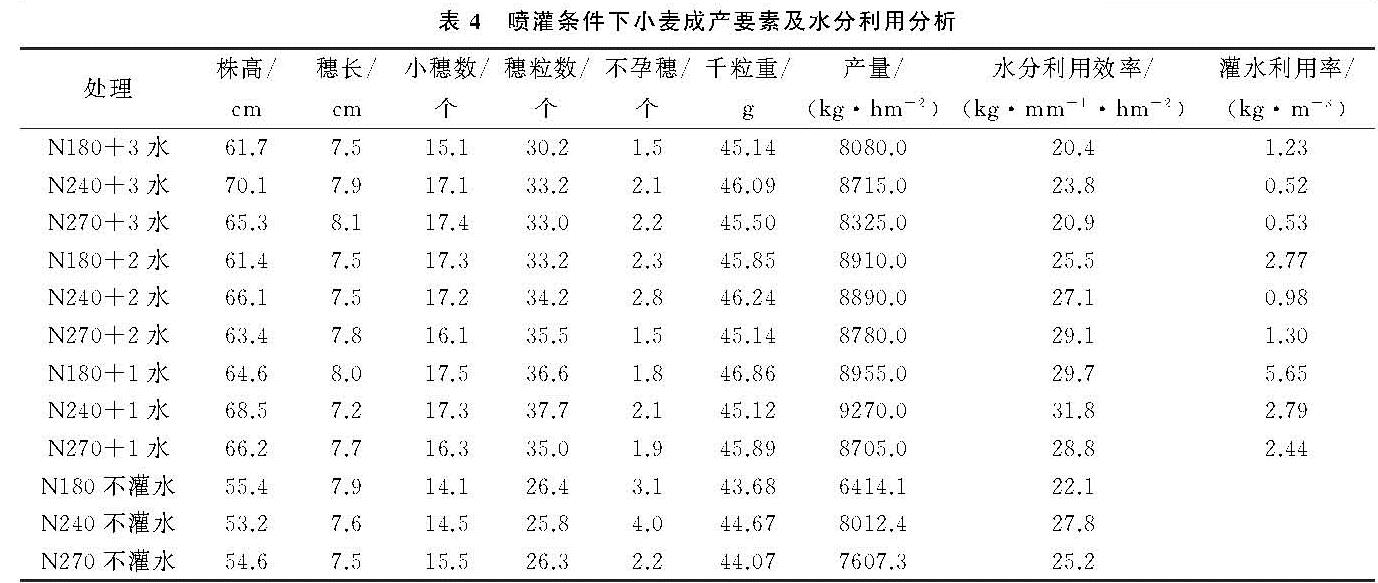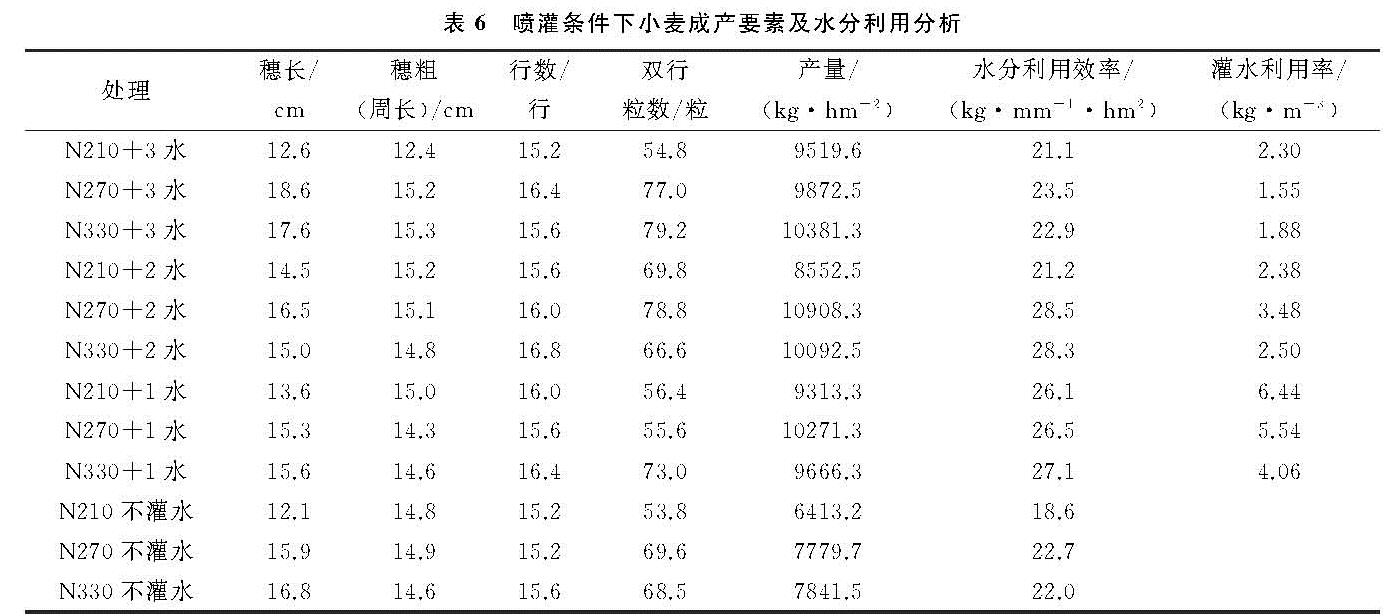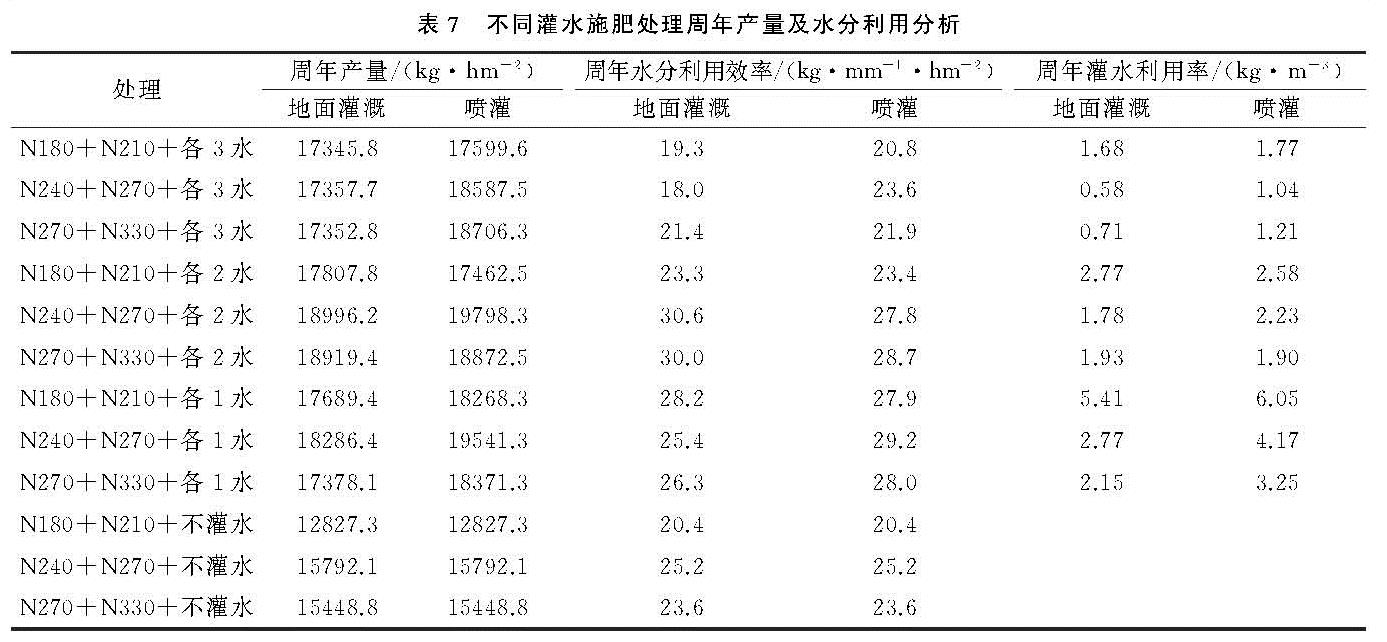2.1 小麦、玉米生育期内降雨量
从小麦、玉米生育期内降雨量可看出(图1),在小麦播种后降雨量逐渐增多,有利于小麦的出苗,但从分蘖期开始到返青期前几乎没有有效降水,从抽穗期开始降雨逐渐增多,一直到小麦收获。玉米播种后降雨主要集中在7月份,之后逐渐减少。小麦生育期内总降雨量为217.4 mm,玉米生育期内降雨量为298.7 mm,小麦玉米生育期内总降雨量为516.1 mm,比往年平均降雨总量减少了40 mm左右。
2.2 不同灌水施肥处理对小麦叶片SPAD值特征的影响
从图2中可知,灌浆期的SPAD值明显高于抽穗期。在不同生育期喷灌不同水肥处理的小麦叶片SPAD值均高于地面灌。在抽穗期,在灌3水条件下,随施氮量的增加,地面灌小麦叶片SPAD值逐渐增加,而喷灌条件下逐渐降低; 在灌2水条件下,随施氮量的增加,地面灌小麦叶片SPAD值先增后减,而喷灌条件下为逐渐增加; 在灌1水条件下,两种灌水方式均随施氮量的增加表现为逐渐增加的趋势。在灌浆期,在灌3水条件下,随施氮量的增加,地面灌小麦叶片SPAD值变化不明显,而喷灌条件下逐渐增加; 在灌2水条件下,随施氮量的增加,地面灌小麦叶片SPAD值逐渐降低,而喷灌条件下为先增后减; 在灌1水条件下,随施氮量的增加,地面灌小麦叶片SPAD值先降低后增加,而喷灌条件下为逐渐增加的趋势。在两个生育期,在不灌水条件下,随施氮量的增加,小麦叶片SPAD值均为先增加后降低的趋势。相同氮肥用量条件下,除灌浆期喷灌条件下外,随灌水量的增加,小麦叶片SPAD值呈降低趋势。整体来看,适度干旱和适宜的施氮量更利于提高小麦叶片的SPAD值,且也中氮水平效果较佳。而喷灌较地面灌更利于小麦叶片SPAD值的提高,但中氮不灌水处理小麦叶片的SPAD值提高更为明显。
图2 不同灌水施肥处理小麦不同生育期小麦叶片SPAD值分析
2.3 不同灌水施肥处理对小麦光合生理特征的影响
从图3中可知,灌浆期小麦的光合速率明显高于抽穗期。地面灌和喷灌不同水肥处理的叶片光合速率均高于地面灌,且均高于不灌水处理。喷灌各处理的光合速率均高于地面灌。在抽穗期,在地面灌条以N240+2水处理的光合速率最高,而喷灌以N180+2水处理更高; 在高水(3水)条件下,随施氮量的增加光合速率明显提高; 在灌1水和2水条件下随施氮量增加变化规律并不一致。在灌浆期,在两种灌溉方式下,均以N270+3水处理的光合速率最高,其次为N180+1水处理; 在灌3水和不灌水时,随氮肥用量的增加,小麦的光合速率呈增加趋势; 在喷灌条件下,灌1水时,随施氮量的增加,光合速率呈下降趋势。在地面灌条件下,在灌1水和2水时小麦光合速率表现为先降后增的趋势。综上,喷灌较地面灌更利于提高小麦叶片的光合速率,促进干物质积累。
2.4 不同灌水施肥处理对小麦不同生育期储水量的影响
从图4和图5中可知,随生育期的推进,小麦储水量表现为先降后增再降而再增的趋势,抽穗期的储水量最高,而灌浆期土壤储水量最低。喷灌条件下各处理变化差异较大。在地面灌条件下(图4),不同生育期以N240+3水处理的土壤储水量较其他处理高,在抽穗期到收获期以N270+2水处理均低于其他处理。在喷灌条件下(图5),在返青期前,不灌水处理明显低于其他处理。在返青期和抽穗期,均以N270+2水处理土壤储水量最高,其次为N240+2水处理和N270不灌水处理。随生育期的推进,各处理间的土壤储水量差异逐渐增大,高氮高水的处理水分消耗较大,因此,储水量明显低于其他处理。在两种灌水条件下,高氮不灌水处理在收获期的储水量均较高。
图4 地面灌不同灌水施肥处理小麦不同生育期储水量分析
图5 喷灌不同灌水施肥处理小麦不同生育期储水量分析
2.5 不同灌水施肥处理对小麦成产要素及水分利用的影响
从表3中可知,在地面灌条件下,随灌水量的增加,小麦的株高、小穗数、及千粒重表现为先增加而后降低的趋势; 而穗粒数呈增加趋势; 千粒重随灌水量的增加表现为先降低后增加而后降低的趋势,灌2水更利于提高小麦的千粒重。在低氮(N180)和中氮(N240)水平,随灌水量的增加,小麦产量表现为先增加而后降低的趋势; 在高氮(N270)水平,小麦产量随灌水量的增加而增加。各处理中,以中氮结合灌水2次(N240+2水)的产量水平最高,为8 768.9 kg/hm2。不同水肥处理中以N180+1水的灌水利用率最高,其次为N180+2水处理,而水分利用效率以N240+2水处理最高,其次为N270+2水处理和N180+1水处理,说明适宜的灌水可有效提高小麦灌水利用率,促进节本增效,有利于土壤水分环境的改善。
从表4中可知,在喷灌条件下,随灌水量的增加,小麦的株高呈增加趋势,而小穗数、穗粒数及千粒重均表现为先增加再降低的趋势。在灌水量相同的条件下,小麦株高随氮肥用量的增加表现为先增加再降低的趋势,其他指标表现并不一致。各处理中,以N240+1水处理的小麦产量最高,其次为N180水平。小麦的灌水利用率以N180+1水处理最高,其次为N240+1水处理,N180+2水处理和N270+1水处理,而水分利用效率以N240 +1水最高,其次为N180 +1水和N270 +2水处理。与地面灌相比,喷灌更利于提高小麦的产量、水分利用效率及灌水利用率。
2.6 不同灌水施肥处理对玉米成产要素及水分利用的影响
前茬小麦水肥处理对后茬玉米产生重要影响。从表5中可知,在地面灌条件下,不同灌水施肥对玉米的形态指标产生不同影响。随灌水量的增加,玉米的穗长与行数呈增加趋势,玉米穗粗和行粒数呈降增降趋势。在相同灌水量条件下,各处理的指标表现各异。最终玉米的产量以N330+2水和N270+2水处理高于其他处理,其次为N270+1水处理。水分利用效率以N330+2水和N270+2水处理最高,其次为N210+1水处理,而灌水利用率以N210+1水处理最高,其次为N270+1水。说明,在本年度玉米全生育期进行1次补灌更利于提高灌水的利用率,实现节本增效。
由表6可知,在喷灌条件下,随灌水量的增加,玉米穗长和行粒数表现为逐渐增加的趋势,而其他指标表现为先增后降的趋势。各处理中以N270+2水处理的产量最高,其次为N330+3水和N270+1水处理。水分利用效率仍以N330+2水和N270+2水处理最高,其次为N210+1水处理,而灌水利用率随灌水量的增加表现为降低的趋势,各处理中仍以N210+1水的处理最高。与地面灌相比,喷灌的玉米产量、水分利用效率与灌水利用率仍均高于对应的地面灌处理,说明,在喷灌条件下,更利于实现节水增产增效。
2.7 不同灌水施肥处理对小麦、玉米周年产量及水分利用的影响
由表7可知,随灌水量的增加,小麦、玉米周年产量表现为先增加后降低,水分利用效率表现为先增加后降低的趋势,而灌水利用率则表现为逐渐降低的趋势。喷灌周年产量和灌水利用率基本均高于地面灌。除灌2水条件下,喷灌的周年水肥利用效率仍高于地面灌。在地面灌条件下,以N240+N270+各2水和N270+N330+各2水处理的周年产量和水分利用效率最高。在喷灌条件下,N240+N270+各2水和N240+N270+各1水处理产量最高,而以N240+N270+各1水处理水分利用效率最高。而灌水利用率在两种灌溉方式下均以N180+N210+各1水处理最高,其次为N240+N270+各1水处理。说明,适当减少灌水次数更利于周年小麦、玉米水分利用率的提高。
